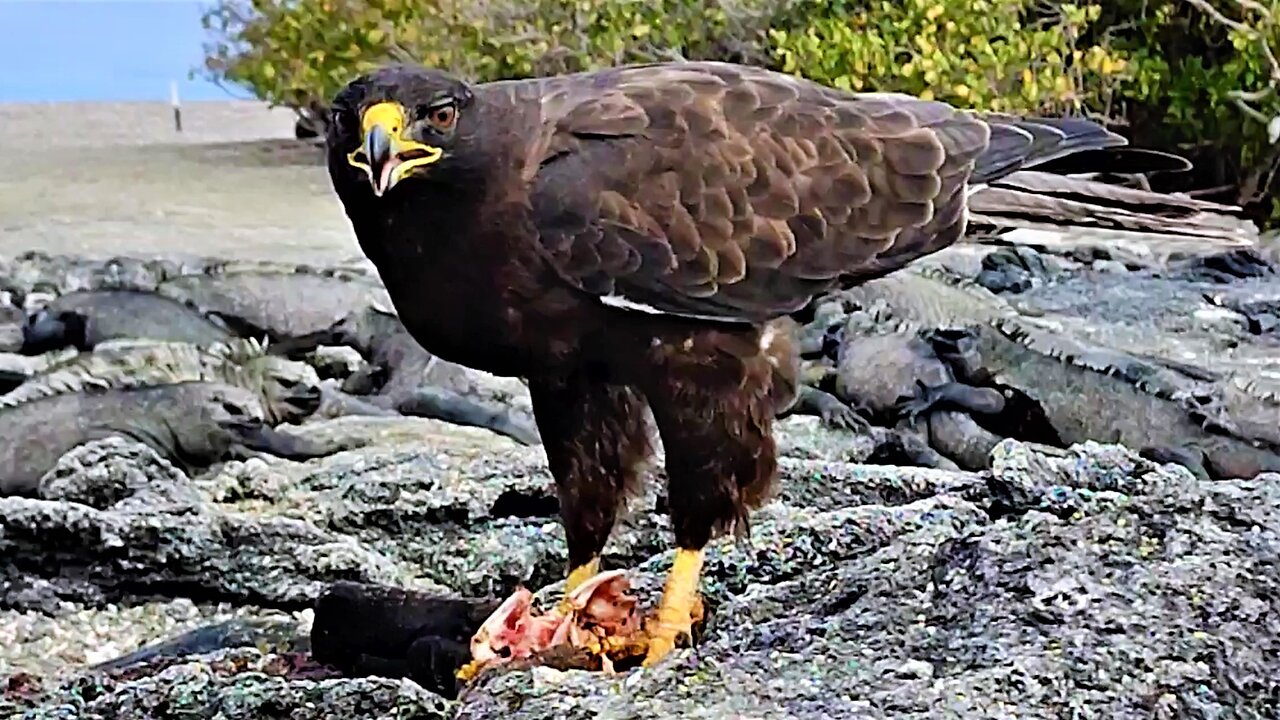Premium Only Content

Nature's brutal side is obvious as Galápagos hawk devours marine iguana
Nature is indescribably beautiful, but it is harsh and brutal at the same time. The animals in our world are fascinating and mysterious, and each one plays a vital role in a web of life that is so intricate and complex that we barely understand it. Most animals are both predator and prey and the balance can change in an instant, and without warning.
Marine iguanas sun themselves on lava rocks to store up energy from the sun. This aids in mobility and also in their task of digesting the algae that they thrive on. A warmer body temperature means a quicker metabolism, crucial for making use of nutrients and for outrunning a threat. Conveniently, their dark skin allows them to absorb sunlight more efficiently, and it helps them blend in and hide on the rocks at the edge of the surf.
But as they sun themselves, they must be wary. One of the predators here that can overcome these large lizards is the Galápagos hawk. The second largest hawk in these islands, it has a wing span that can reach 140cm (55 inches). It swoops nearly silently in on unsuspecting iguanas and sea lion pups. With sharp talons and an equally sharp beak, it can overcome and kill its prey with ease.
This hawk devours its catch on the rocks without concern. There are few animals here that will challenge such a fearsome bird. Surprisingly, the other iguanas show little regard for the hawk, likely understanding that it is too busy with its meal to pose a threat to them. But generally, these lizards keep a watchful eye on the skies above for a sign of a circling threat. Smaller lizards often hide under rocks or in crevices until they are big enough to deter the hawks. The iguanas themselves have large claws, powerful tails, and strong beaks. Unless the hawk makes a precise grasp at the lizard and finishes it quickly, the lizard may inflict some damage in the battle before it is killed.
Galápagos hawks are known for their fearlessness. They show little fear of humans, as is obvious in this case where the hawk continues to feed even as it is being recorded. Charles Darwin commented on the fact that the hawks were unaffected by his presence. He stated that his gun was superfluous as he used the muzzle to push a hawk out of a tree that he was close to. The hawk made no effort to leave until he persuaded it to do so. This may have contributed to the rapid decline in their numbers when humans arrived on these islands. There are only 150 mating pairs in existence today. They have become extinct on several of the islands. It is estimated that they arrived only 300,000 years ago, making them the most recent arrival of all the native species in the Galápagos. In contrast, the finches that Charles Darwin wrote so much about are believed to have arrived here 2-3 million years ago.
Galápagos hawks mate throughout the year. Due to the consistency of weather and food supply at the equator, they have no specific mating season. They build their nests low in the trees, on lava ledges, or on the ground. Although they lay 2-3 eggs, only one of the young will be reared. The young will leave the nest after approximately two months.
These beautiful birds are awe-inspiring. As we learn more about them, we will become better able to help them recover their populations.
-
 1:15:15
1:15:15
JULIE GREEN MINISTRIES
3 hours agoTHE CIA HAS BEEN A GIANT IN THIS LAND THAT WILL BE TAKEN OUT
67.7K116 -
 3:58:26
3:58:26
The Bubba Army
1 day agoBURN The FLAG, Go to JAIL! - Bubba the Love Sponge® Show | 8/26/25
54.5K19 -
 29:45
29:45
DeVory Darkins
17 hours ago $7.39 earnedDemocrat Governor suffers EMBARRASSING LOSS to Trump as ICE takes Garcia into custody
27.1K74 -
 18:22
18:22
World2Briggs
21 hours ago $2.99 earnedThe New York Rant: Point Blank With No Fluff or BS. A Warning
19.3K7 -
 42:52
42:52
The Finance Hub
15 hours ago $4.23 earnedBREAKING: ALINA HABBA JUST SHOCKED THE WORLD!
22.7K36 -
 2:00:44
2:00:44
BEK TV
1 day agoTrent Loos in the Morning - 8/26/2025
23K -
 12:15
12:15
Nikko Ortiz
19 hours agoMonday Gun Fails
82.3K18 -
 8:19
8:19
MattMorseTV
19 hours ago $12.78 earnedTrump is ACTUALLY DOING IT.
76.5K55 -
 5:40
5:40
Sugar Spun Run
1 day ago $1.30 earnedNutella Brownies
27.7K2 -
 8:46
8:46
Faith Frontline
18 hours agoBill Maher STUNNED as Charlie Kirk Proves God Exists
27.7K21